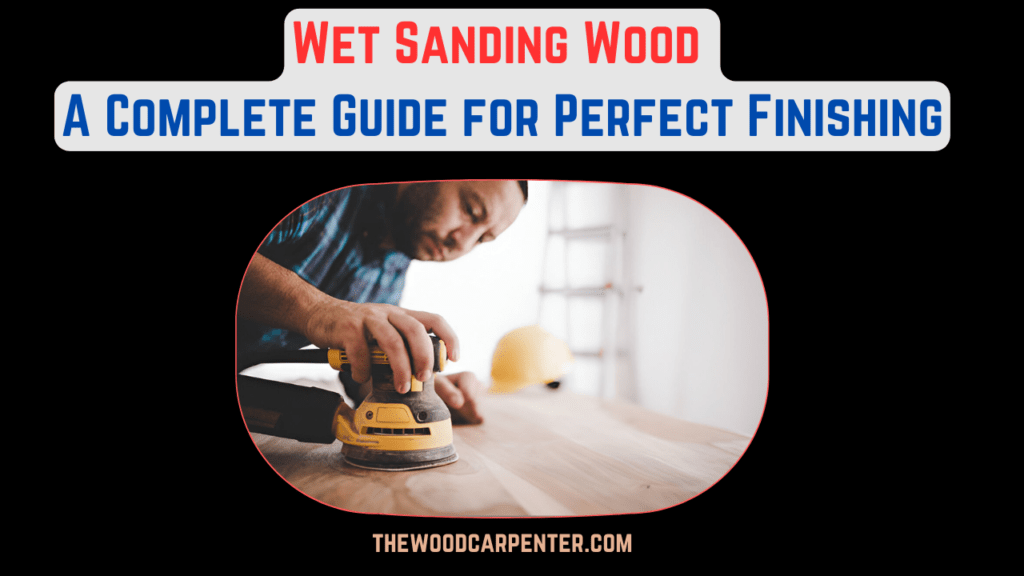
Wet Sanding
Wet sanding is a way to make wood feel extra smooth and look perfect. Whether you’re building something with wood, fixing up old furniture, or getting wood ready to paint, wet sanding can help you get a clean, professional finish.
It works by using sandpaper with water or another liquid to reduce heat and friction while sanding. This keeps the surface cool and helps remove tiny scratches. Wet sanding is great for the final touch when you want the wood to feel super smooth.
In this article, we’ll show you how to do wet sanding, what tools you’ll need, and why it’s a useful step for getting the best results.
What Is Wet Sanding?
Wet sanding uses special waterproof sandpaper and a liquid (usually water, sometimes with a bit of dish soap or mineral spirits) to sand wood. The liquid helps reduce friction and heat, keeps dust down, and stops the sandpaper from getting clogged with wood. This method is mostly used in the final steps when you want a smooth, perfect finish that looks almost like glass.
Why Should You Use Wet Sanding for Wood ?
Smoother Surface: Wet sanding helps to achieve a smoother, more even surface, perfect for finishing.
Prevents Dust Buildup: The water traps dust particles, reducing mess and improving the air quality in your workspace.
Reduces Friction and Heat: This minimizes the risk of damaging the wood surface and ensures a cooler sanding process.
Eliminates Scratches: Wet sanding removes minor scratches and blemishes, leaving a refined finish.
Ideal for Finishing: This technique is perfect for prepping wood before applying paint, stain, or lacquer.
Also read: Osmo Polyx Oil: How to Apply in 10 Simple Steps
Tung Oil vs Danish Oil: A Comprehensive Comparison
When to Use Wet Sanding
It is best used:
As a final finishing step for high-gloss or mirror-like finishes
Between coats of varnish, lacquer, or paint to smooth out imperfections
On hardwoods and sealed or painted surfaces (avoid on untreated softwoods, which may absorb excess water and swell)
Tools You’ll Need
- Waterproof sandpaper (grits from 180 up to 3000, depending on the finish desired)
- Sanding block or sponge for even pressure
- Spray bottle or bowl with water (add a drop of dish soap for extra lubrication)
- Microfiber cloths or sponges for wiping slurry and cleaning
- Protective gear: gloves, mask, and safety glasses.
Step-by-Step Guide to Wet Sanding Wood
Step 1: Set Up Your Workspace
Before you start, make sure your area is well-lit and easy to clean. Since wet sanding can be messy, lay down a drop cloth or plastic sheet to catch any drips.
Step 2: Choose the Right Sandpaper
Pick a sandpaper grit depending on how smooth you want the wood. Start with a coarser grit (180-220) to smooth out the surface. If you’re sanding after applying a finish, use a finer grit (400-600) to get rid of imperfections. Gradually use finer grit to make the surface smoother.
Step 3: Wet the Sandpaper
Soak your sandpaper in water for a few minutes. This softens the abrasive particles, making sanding smoother. If you’re using a spray bottle, just spray the sandpaper or wood with a light mist to keep it wet.
Step 4: Start Sanding
Sanding should be done with light pressure in a circular or back-and-forth motion. Don’t press too hard, or you might damage the wood or make it uneven. Keep dipping the sandpaper in water to keep it moist.
Step 5: Wipe and Check the Wood
After sanding a small area, wipe away the moisture with a clean towel. Check the surface for any imperfections or scratches to decide if you need to use a finer grit sandpaper.
Step 6: Repeat the Process
Keep sanding with finer grits, wetting the sandpaper and wiping the wood until it’s smooth and even. This is especially important if you want a shiny finish, like on furniture or cabinets.
Step 7: Clean Up and Finish
Once the wood is smooth, clean the surface and let it dry. Then, you can apply your final finish, like stain or polyurethane, to protect the wood and make it look even better.
Wet Sanding vs. Dry Sanding: A Quick Comparison
| Aspect | Wet Sanding | Dry Sanding |
| Dust Production | Minimal | High |
| Finish Quality | Polished, ultra-smooth | Coarse to semi-smooth |
| Sandpaper Life | Longer (less clogging) | Shorter (clogs quickly) |
| Cleanup | Easier (water slurry) | Requires thorough cleanup |
| Best Use | Final finishing, gloss work | Material removal, shaping |
Also read:
Beeswax Wood Finish: The Secret to Stunning Wood
Wood stain: How long does it take to dry?
Pro Tips and Common Mistakes to Avoid
- Always use waterproof sandpaper-regular sandpaper will break down in water.
- Don’t oversaturate the wood-too much water can cause swelling or damage, especially in softwoods.
- Progress through grits methodically-don’t skip grits, or you may end up with uneven results.
- Test on a small area first to ensure compatibility and desired effect.
- Use light pressure-let the sandpaper do the work to avoid gouging or damaging the surface.
- Wear protective gear to avoid irritation from fine wood particles and water.
When to Use Wet Sanding vs. Dry Sanding
Wet sanding is best for getting a smooth, glass-like finish. It’s great for fine details, wood turning, or when working with finishes like varnish or lacquer. Dry sanding, however, is better for tough jobs, like sanding rough wood surfaces or large, unfinished areas.
Can You Wet Sand Without Water?
Though water is usually the go-to lubricant for wet sanding, you can also use other liquids like mineral spirits, oils, or special lubricants. These can be helpful when working with finishes that don’t mix well with water.
Conclusion
Wet sanding is a great way to achieve a professional, smooth finish for your wood projects. It helps get rid of scratches, smooths the surface, and prepares the wood for painting or staining.
While it can take some time, the results are definitely worth it. By following these steps, you can make your wooden items look beautifully finished.
FAQs
1. What type of sandpaper should I use for wet sanding?
For wet sanding, use wet/dry sandpaper, which is designed to resist moisture and maintain its abrasiveness. Grits typically range from 180 to 1500, depending on the finish you desire.
2. Can I use a power sander for wet sanding?
Yes, you can use a power sander for wet sanding. However, make sure to keep the sander moving gently over the surface to avoid damaging the wood.
3. How do I know when to stop wet sanding?
Stop wet sanding when the surface is smooth and free from imperfections. The wood should feel velvety to the touch, and you should have no visible scratches or marks.
4. Is wet sanding better than dry sanding for furniture?
Yes, it is generally better for furniture, especially when a high-gloss finish is desired. It helps achieve a smoother surface with fewer visible sanding marks.
5. Can wet sanding be used on all types of wood?
It can be used on most types of wood, but always test on a scrap piece first, especially with softer woods like pine, as excessive moisture can affect their texture

